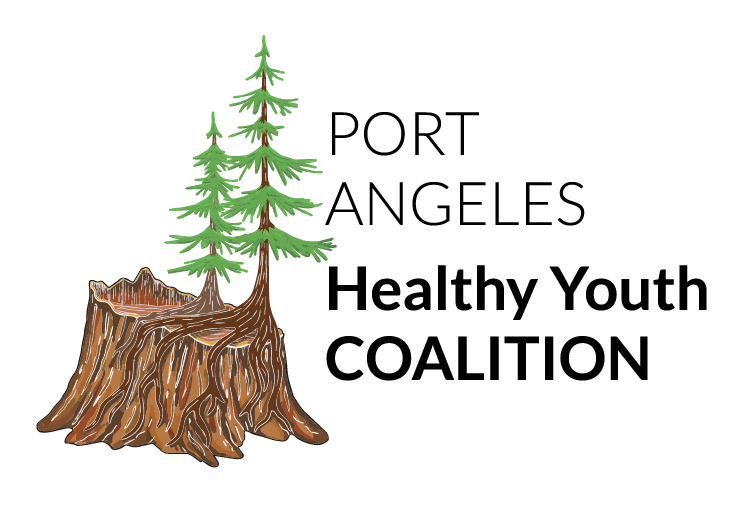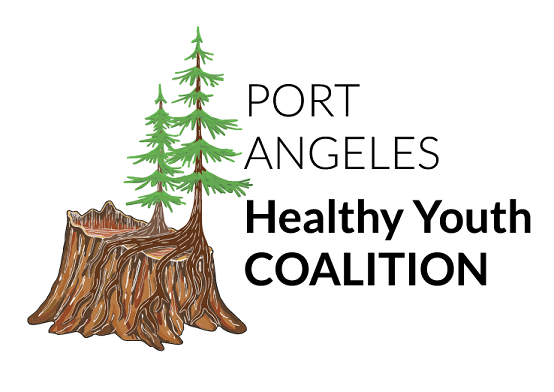A community-based coalition dedicated to youth substance misuse prevention in Port Angeles, Washington.
FAQs
-
Use = Misuse
All underage use of alcohol, cannabis/marijuana, tobacco, and other substances is categorized as “misuse.”
Substance misuse is the use of alcohol, cannabis, over-the-counter or prescription medications, and other substances in a way that they are not meant to be used. Over time, substance misuse can become substance abuse, an unhealthy way to respond to stress and anxiety, particularly when managing a chronic illness, mental health challenges, or unaddressed hardship like an adverse experience, toxic stress, and trauma.
-
90% of addictions start in high school. A person goes through a lot of changes in adolescence and early adulthood—especially the brain, which won’t be finished developing until someone is in their mid-twenties.
Early initiation or exposing your brain to substances early in life rather than later increases the risk of addiction or dependency.
Why? Alcohol, cannabis, and other substances temporarily increase the chemical messenger in your brain called dopamine, making you feel good. But this system can be taken over when someone uses these substances while the brain is still developing.
When you use a substance, a new neuropathway is built based on this reward. As with learning something new, this pathway is easier to build and strengthen in a younger brain. The result is that a young person can become addicted more quickly – and more heavily – than an adult.
Short and Long Term Impacts: Substance use during childhood, adolescence, and young adulthood can have lasting effects on the brain. Even short-term use can interfere with a young person’s ability to learn and remember – and impact academic success, sports, and activities.
Visit https://drugfree.org for more information.
-
Prevention acknowledges that individuals usually make the best choices available to them. For example, factors such as abuse and neglect, toxic stress, a history of addiction in the household, or other adversities may constrain those choices.
Prevention strategies are universal and provide all individuals with the same information and skills necessary to prevent substance misuse and abuse. Everyone shares the same general risk for misusing or abusing substances, although the risks and protections vary from person to person.
Prevention requires the greatest amount of commitment and collaboration across all sectors of the community over a sustained period to show significant results. In the long term, prevention has been shown to have the greatest impact in reducing harm from substance misuse and abuse and reducing the number of people experiencing addiction.
Visit https://www.samhsa.gov/find-help/prevention for more information.
-
The Institute of Medicine’s Continuum of Care is a classification system that we use within the Port Angeles Healthy Youth Coalition to define the scope of our work.
Indirect and Direct Universal Prevention are strategies that target everyone, not on the basis of risk, by addressing knowledge, attitudes, and behaviors that help everyone to succeed and reduce the likelihood of misusing or abusing substances.
Since childhood experience can have a lasting impact on a person’s life, the Coalition focuses on prevention strategies that foster positive development from infancy through young adulthood.
-
The Port Angeles Healthy Youth Coalition utilizes the Excellence in Prevention strategy list and Continuum of Evidence of Effectiveness created by the Center for Disease Control and Prevention to select prevention programming.
According to the best available research, the Coalition selects strategies that are evidence-based and well supported. We also review potential programs on the basis of cultural and geographic relevance, feasibility, and partner/community readiness.
-
The Port Angeles Healthy Youth Coalition is awarded state and federal grants through the Washington Health Care Authority’s Community Prevention and Wellness Initiative. This funding allows us to deliver events and programs, and disseminate prevention-related materials at no cost.
To explore upcoming events and training opportunities visit our Events page.





